Session 4
| Site: | MoodleHUB.ca 🍁 |
| Course: | Early Learning and Child Care 30 Modules |
| Book: | Session 4 |
| Printed by: | Guest user |
| Date: | Thursday, 18 December 2025, 10:35 AM |
Description
Created by IMSreader
1. Session 4
Session 4: Providing for Play
Introduction

© Glenda Powers/6075624/Fotolia
Play experiences promote development in all areas of development; therefore, it is important for children to engage in play that interests them.
What skills does a caregiver need in order to facilitate children’s play? How do the environment, the age group, and the children affect how positive play occurs?
This session focuses on play and on how child care providers plan and prepare for children’s exploration. If child care providers understand how to provide for play, children’s development is enriched.
By enhancing the learning environment with the use of appropriate play spaces, materials, and child-care-provider involvement, children benefit from the many ways to play.
1.1. Get Focused
Session 4: Providing for Play
Getting Focused Activity: Help Me to Play
Focus
Have you ever wondered why one play activity works and one doesn’t, even though you planned both activities carefully? Child care providers who effectively plan, observe, and then participate in children’s play have to be aware of many different cues in the environment.
Directions
Step 1: Read Scenario 1 and Scenario 2.
Step 2: Complete Getting Focused Activity: Help Me to Play.
 Checking In
Checking In
Save your completed learning activity in your course folder.
1.2. Inquiry 1
Session 4: Providing for Play
Inquiry 1: Nurturing Play
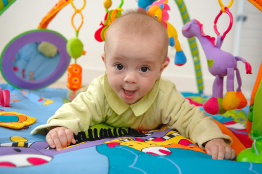
© NICOLAS LARENTO/3383175/Fotolia
Always remember to help children grow beyond their current capabilities by using both indirect and direct strategies.
Play is the key to aiding in the social, physical, intellectual, creative, emotional, and language development of children. It is important that child care providers organize and regularly evaluate the child care environment in order to enrich children’s play and encourage them to learn through self-exploration.
The nature of children’s play is based on several concepts, including the environment and the child care providers in the room. Trusting adults who provide appropriate, safe, and nurturing play opportunities encourage positive interactions among children and between children and adults. The ability to create these positive relationships will establish trust, encourage independence, and foster self-esteem in children.
Children will play anywhere at any time, and it is the child care provider’s responsibility to nurture those opportunities. Child care providers should be non-intrusive and encouraging to children to help them discover, gather, and use information, and to learn to problem solve in a positive, productive, and supportive manner.
Important: Child care providers guide children by providing a variety of opportunities and experiences for age-appropriate exploration and learning.
1.3. Learning Activity 1
Session 4: Providing for Play
Learning Activity 1: Facilitating Play for All Children
Focus
Being able to facilitate the play of all children is, perhaps, the most critical skill of child care providers.
Directions
Step 1: Read the article “Play and Relationships: Programming for Inclusion.”
Step 2: Complete Learning Activity 1: Facilitating Play for All Children.
 Checking In
Checking In
Save your completed learning activity in your course folder.
1.4. Inquiry 2
Session 4: Providing for Play
Inquiry 2: The Circle of Facilitation
Facilitating children’s play is an ongoing process. The child care provider’s responsibility includes setting up the space, participating in and facilitating play experiences, and observing activities. Together, these three processes are referred to as “The Circle of Facilitation.”
While there isn’t a “correct” starting place on the circle of facilitation, child care providers often begin with observing children so that they can learn the interests and needs of each child.
Each component in the circle of facilitation is important on its own and in combination with the other components.
By constantly evaluating all levels of play, a child care provider can provide an exciting, dynamic, and encouraging play space.
Setup
There are many highly desirable characteristics of children’s play spaces and many considerations child care providers must make. The following guidelines must be met to ensure developmentally appropriate play spaces.
Safety
- The child explores freely and safely. For children who have specific needs (e.g., impaired sight or hearing, limited mobility, and so on), special considerations may need to be made.
- Equipment and materials are in good condition, not broken.
- Play spaces are visible to child care providers to ensure proper supervision (being able to see all children at all times).
- Safety standards are followed (e.g., playground equipment is in good repair).
- Outdoor areas are safe (e.g., free from glass, appropriate cushioned surfaces under fall zones, and so on).
Movement
- Children need daily opportunities for large and small body movement (fine and gross motor play).
- Modifications are made for children who use mobility devices to ensure that they have free movement within the facility. Spaces are flexible to accommodate children’s needs and interests.
- There is adequate space for the children in which they can pretend play, use sand and water, make crafts, read, play with manipulatives, and so on.
Self-Expression
- Children have many opportunities to use materials in different ways.
Interaction
- Younger children prefer smaller groups and often engage in individual activities, while older children often play together and need more space. A variety of play materials is always required in sufficient quantity (especially to minimize the need to share for younger children.)
Privacy
- Children have the opportunity to be alone in a visible, quiet, safe space.
Adequate and Accessible Materials
- There are enough materials for the children to engage in a variety of play experiences, minimizing the need to share, take turns, and wait to play.
- Materials are stored on low, open shelves for easy access by children.
Choices
- Play areas have a variety of materials that are developmentally appropriate for the age group.
Child-Sized Furnishings
- Furniture and fixtures, such as sinks, toilets, displays, climbers, chairs, and tables, are size-appropriate for the children who use them.
- Children’s feet are able to touch the ground when they are sitting on chairs.
Defined Play Spaces
- Play spaces are well laid out to create specific interest centres (manipulative/table-top centre, quiet/reading area, water table, sand table, large muscle area, art centre, dramatic play/housekeeping area) and other activities.
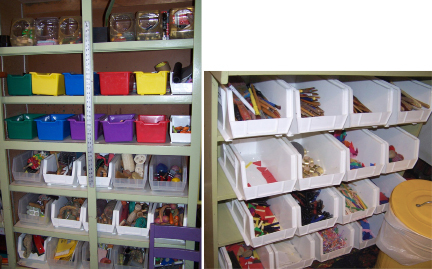
Sherry Duncan
Organization of Storage Space
- Organize craft supplies and other manipulative materials by placing coloured dots on the containers that hold puzzles, beads, boxes, crayons, and so on. Place matching dots on the shelves where these items are stored so that children can easily identify where each item should go.
-
Trace the outline of tools on a pegboard so that children can hang tools in the appropriate places.
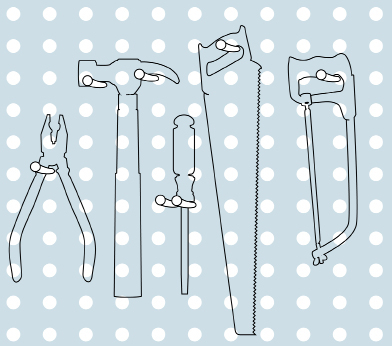
- Draw symbols on cupboards or boxes to indicate which items are stored in which spaces.
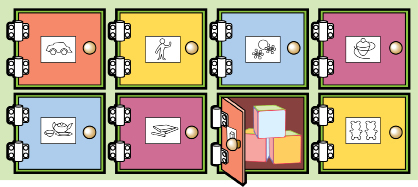
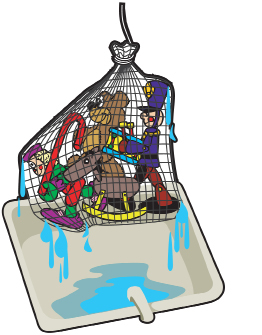
© adapted from 2009 Jupiterimages Corporation
-
Place wet toys from the water table in a net bag hung over the water table or in a sink, so that water can drain from the toys.
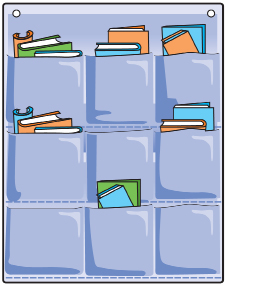
-
Place books in a book organizer, similar to a shoe organizer, that has pockets large enough to hold books. Hang the book organizer on the wall or on another vertical surface, such as the back of an upright piano or a bookshelf.
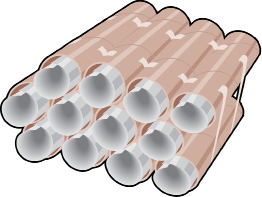
- Cardboard tubes, such as those used for mailing calendars and posters, or paper towel rolls can be glued together to create a place for storing children’s artwork and keeping it wrinkle-free.
1.5. Page 2
Session 4: Providing for Play
Possibilities with Prop Boxes
Prop boxes are used to add new ideas to children’s dramatic play. Prop boxes are usually based on a theme (e.g., grocery store) and are added to the dramatic play area. Prop boxes encourage children to role-play and think about concepts they are not exposed to on a daily basis.
Prop boxes are composed of specialized items combined to foster a specific type of play. It is a box of pretend or real, ordinary housewares that can provide hours of enjoyment for a child as well as a developmentally educational experience.
Take a few minutes to investigate prop box ideas in “Possibilities with Prop Boxes.”
Prop boxes can be work-oriented, and may lead children to learning about diverse occupations. Prop boxes may be started as children need materials to extend their play (e.g., electrical switches, wire, and pliers for the electrician; plastic flowers and vases for the florist) or put together as requested by children playing in the various play centres. Children may also create items that they want to add to a prop box.
Prop boxes need to
-
be flexible
-
be versatile
-
be easy to carry (have handgrips)
-
be used indoors and outdoors
-
contain real or realistic items
-
be tough yet lightweight
-
be easily identifiable (be coded with pictures of what they contain)
The contents of a prop box will constantly grow—the box will fill up, and probably start to spill over, as everyone finds or makes things to add.
For more creative ideas, read “Creating Toys and Activities for Children from ‘Beautiful Junk.’” You can also watch video clips of Mr. Dressup and his tickle trunk on the Internet. Mr. Dressup was a popular Canadian children’s entertainer. In his show, Mr. Dressup encouraged imagination through the tickle trunk, which contained a wide variety of objects to spark children’s creativity.
 Course Project
Course Project
Have you finished 20 items and strategies for your strategies box? If not, be sure to finish your items and strategies as you work through this session. Remember to apply the information presented in this session to your strategies.
1.6. Learning Activity 2
Session 4: Providing for Play
Learning Activity 2: Designing a Prop Box
Focus
When child care providers put together prop boxes and organize playtime, they are providing opportunities for children to learn through play. Child care providers need to plan space, time, materials, and guidelines for play.
Directions
Step 1: Choose one of the following themes or occupations around which a prop box or play centre could be made:
- veterinary clinic
- bookstore
- pet store
- office
- post office
- school office
- dentist’s office
- toy store
- clothing store
- bank teller
- zookeeper
- beach
- teacher
- janitor
- dance studio
- fitness studio
- fire station or police station
- restaurant
- mechanic shop (cars, bikes, trains, planes)
- astronaut
Step 2: Collect items that could be added to your prop box.
Step 3: Select and decorate a box for your items.
Step 4: Complete Learning Activity 2: Designing a Prop Box.
Step 5: Review Student Rubric for Learning Activity 2: Designing a Prop Box. Assess the quality of your work and make any necessary adjustments.
 Checking In
Checking In
Save your completed learning activity and your self-assessment in your course folder.
1.7. Inquiry 3
Session 4: Providing for Play
Inquiry 3: Stages of Play
Social Stages of Play
Consider the following social stages of play.
|
Social Stages |
Description |
|
Solitary Play |
Children are engaged in this stage of social play when they are playing alone and ignoring those around them. They are very focused on themselves and the objects with which they are playing. Their play is independent of those around them, and they play with different materials than other children in the immediate play area. |
|
Parallel Play |
Parallel play occurs when children are playing side-by-side with similar objects but do not attempt to interact with one other. The children come and go as they please. |
|
Associative Play |
Children engaged in associative play are playing similar activities, but each child is still doing his or her “own thing”; in other words, the children don’t exchange ideas. Each child plays as she or he wants to, but there is some understanding among the children that they are doing the same thing. |
|
Cooperative Play |
In this stage of social play, children who are playing together take turns being the leader and they share roles and exchange rules. For example, they might say, “I’ll be the mommy and you be the baby.” |
|
On-Looking and Unoccupied Play |
Sometimes children stand back and watch something of interest to them. On-looking play occurs when a child spends time watching other children play. Unoccupied play occurs when a child spends time in a variety of non-play behaviours. |
Creative Stages of Play
There are three stages of creative play: basic exploration, non-representative, and representative. In other words, at different creative stages, the same toy may be an object to be explored, an object to be manipulated without an understanding of its purpose, or an object with a specific purpose.
When children learn a new way to play, they may still engage in earlier stages of play. The following chart identifies the ways children play at different ages.
A child’s level of development influences the way the child plays. Children can engage in solitary play in all age groups; however, it is not until age three or four that children begin to participate in cooperative play.
|
Social Stages of Play |
Creative Stages of Play (How Children Use Materials) |
||
|
Basic Exploration |
Non-Representative |
Representative |
|
|
Solitary Play
|
Infants
A baby might use a rattle by sucking on it.
|
Toddlers
A toddler might use the rattle to hit another toy.
|
Toddlers
A two- or three-year-old might shake the rattle to the beat of a song he or she is singing.
|
|
Parallel Play |
Toddlers
Two toddlers might each (but separately) leave a trail of blocks, as Hansel and Gretel did, so that they can find their way back to the swings.
|
Toddlers
Two toddlers might play beside each other as they organize blocks into rows.
|
Younger Preschoolers
Two young preschoolers sit side-by-side as they each build their own tall towers.
|
|
Group Play (Associative and Cooperative Play)
|
Preschoolers
A small group of four- and five-year-old preschoolers use paintbrushes as drumsticks while they play drums together like members of a band.
|
Preschoolers
Two four- and five-year-old preschoolers use paintbrushes and, together, paint a picture of their houses and families.
|
|
Consider the following characteristics of play by age group:
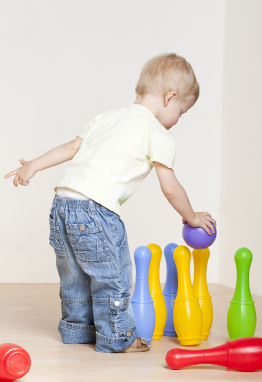
© PHB.cz/28022931/Fotolia
Infants
- Infants typically play for short periods of time.
- Infants use their senses to explore by looking, smelling, tasting, banging, moving, listening, and shaking. This is referred to as sensorimotor play.
- Infants play by responding to social interactions; for example, by cooing, smiling, and laughing.
Toddlers
- Toddlers typically pretend-play with objects such as toy cups, spoons, and dolls. They like to play with adults, pretending to feed others, or pretending to talk on the phone.
- Toddlers like to use “pretend” objects as long as they are similar to real objects.
Preschoolers
- Preschoolers like to role-play stories from books and movies.
- Preschoolers enjoy many kinds of play, including associative play.
1.8. Page 2
Session 4: Providing for Play
 Checking My Understanding
Checking My Understanding
Social Stages of Play
Directions
For each of the following situations, indicate which social stage of play (solitary, parallel, associative, cooperative, and on-looking or unoccupied) the children are engaging in. After you’ve finished, check your answers.
- Clara stands at the side of the block cupboard watching Sara play in the water table. Clara stretches her neck to see all of the toys Sara is using.
- solitary play
- parallel play
- associative play
- cooperative play
- on-looking or unoccupied play
- Kalera, 2.3 years, and Miranda, 3.1 years, are playing with blocks. Kalera has a dump truck and is putting smaller blocks in the truck. He then drives the truck to the other side of the block area and dumps the blocks on the floor to form a shape.
-
solitary play
-
parallel play
- associative play
- cooperative play
- on-looking or unoccupied play
- Stephanie is standing by the water table looking around. She doesn’t seem to be looking at one thing for too long.
-
solitary play
-
parallel play
-
associative play
-
cooperative play
-
on-looking or unoccupied play
- Natalie, 2 years, is sitting on the floor in the block area. One-by-one she takes the blocks off the shelf and puts them side-by-side on the floor, and then knocks them over.
-
solitary play
-
parallel play
-
associative play
-
cooperative play
-
on-looking or unoccupied play
- Paul and Rania are building their own structures in the block area. Paul says, “When we are finished, let’s blast off in our spaceships!” Rania says, “Mine has a super turbo blaster! Let’s go!”
-
solitary play
-
parallel play
-
associative play
-
cooperative play
- on-looking or unoccupied play
- Sebastian, 3 years, wanders into the block area and watches several children work together on a structure. After a minute, he walks by the water table and keeps going to the art table, where he doesn’t pick up a brush or paper to paint.
- solitary play
- parallel play
- associative play
- cooperative play
- on-looking or unoccupied play
- Katie, 2 years, alternates red and blue building blocks while Teri, 2 years, is sitting near her using blocks to build a tower. They seem influenced by each other, but neither child talks or suggests anything to the other.
-
solitary play
-
parallel play
-
associative play
-
cooperative play
-
on-looking or unoccupied play
- Carl, 5 years, and Fin Yee, 5 years, see a large box in the corner of the room. They decide to turn it into a spaceship. They get paint and colour the box, and then take turns saying, “Blast off, captain!” “Yes, sir.”
-
solitary play
-
parallel play
-
associative play
-
cooperative play
-
on-looking or unoccupied play
- Soon Yi, 2 years, works at building a mountain out of paper. She doesn’t talk to anyone and is not involved with the children around her.
-
solitary play
-
parallel play
-
associative play
-
cooperative play
-
on-looking or unoccupied play
1.9. Learning Activity 3
Session 4: Providing for Play
Learning Activity 3: Observing Children’s Social and Creative Stages of Play
Focus
Observation of children’s play is central to planning appropriate play activities. By observing both the social and creative stages of play, a child care provider can create an environment that best meets the developmental needs and interests of the children.
Directions
Step 1: You have been to a child care facility several times by this point in the course. Think back to your observations of children engaging in different social stages of play and different creative stages of play. If necessary, return to the child care facility to make observations.
Step 2: Complete Learning Activity 3: Observing Children’s Social and Creative Stages of Play.
 Checking In
Checking In
Save your completed learning activity in your course folder.
1.10. Inquiry 4
Session 4: Providing for Play
Inquiry 4: The Child Care Provider’s Role in Children’s Play

© Pavel Losevsky/2302117/Fotolia
Child care providers who understand the need for children to play, who know what play is, and who know how to participate in play are able to provide a quality program.
When child care providers facilitate play, they guide children by providing support, empowerment, and enhancement. The goal of a child care provider who plans, observes, and facilitates enriched play activities is to enhance a child’s self-esteem and sense of achievement.
Child care providers supervise play, but they are also actively involved in children’s play. This participation lets children know that their play is important and, as a result, the children’s play and learning are often extended.
Child care providers can involve themselves in children’s play in many different ways:
-
playing beside the children
-
extending play activities by adding materials
-
participating with the children
-
asking questions to stimulate conversations and learning
-
noticing a child playing with a certain toy or participating in a certain activity
-
noticing and responding to a child’s question or idea
-
intervening in difficult play activities or misunderstandings
Child care providers should do the following:
-
become involved in play
-
avoid interrupting play
-
support and extend play
-
observe activities to identify individual learning
-
keep the activities safe and offer ideas to encourage safe play
-
redirect play when play becomes inappropriate
-
encourage children to problem solve when misunderstandings occur
1.11. Learning Activity 4
Session 4: Providing for Play
Learning Activity 4: Being Involved in Children’s Play
Focus
An essential part of the play process is child care providers’ involvement in children’s play.
Directions
Step 1: Read Five Scenarios.
Step 2: Complete Learning Activity 4: Being Involved in Children’s Play.
 Checking In
Checking In
Save your completed learning activity in your course folder.
1.12. Session 4 Summary
Session 4: Providing for Play
Session Summary
Important: The quiz may contain questions beyond points highlighted in this summary. Be sure to review the session thoroughly.
Review Session 4 to prepare for writing the quiz. As you review, note the sections that connect with the following points:
- This session provided you with a number of specific methods for establishing a dynamic play environment for children.
- To facilitate play, a child care provider must provide a variety of safe and age-appropriate materials in the environment, observe children and their play, and be involved in or around the children’s play.
- Facilitation is based on observation and the environment by providing space, time, materials, and guidelines.
- Observation is based on watching both the social and creative stages of play. The child care provider then plans the environment based on the developmental and individual needs of the children.
- Involvement in children’s play should be constructive—adding materials when needed and intervening in disputes and redirecting play.
- Plan play so that it encourages children to have personal direction and develop social, physical, intellectual, creative, emotional, and language skills.
Session Quiz
 Checking In
Checking In
Contact your teacher to decide together when and where you will complete the Session 4 Quiz.